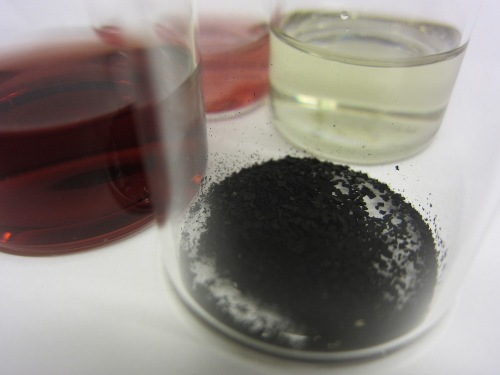A research team from the Massachusetts Institute of Technology has developed a new technique to increase the stability of copper nanoparticles, while decreasing the energy required for them to reduce carbon dioxide to hydrocarbon fuels such as methanol or methane.
 Researchers have combined gold nanoparticles (in light red) with copper nanoparticles (in light green) to form hybrid nanoparticles (dark red), which they turned into powder (foreground) to catalyze carbon dioxide reduction. (Photo: Zhichuan Xu)
Researchers have combined gold nanoparticles (in light red) with copper nanoparticles (in light green) to form hybrid nanoparticles (dark red), which they turned into powder (foreground) to catalyze carbon dioxide reduction. (Photo: Zhichuan Xu)
The research team has developed hybrid nanoparticles by mixing copper nanoparticles with gold. These nanoparticles can be utilized as a potentially energy-efficient method of decreasing greenhouse gas emissions from power plants, according to Kimberly Hamad-Schifferli, one of the researchers. The team selected to engineer the nanoparticles as they have a larger surface area for reaction with carbon dioxide molecules. Gold was mainly selected because of its common properties. The addition of gold prevents copper oxidation.
To synthesize the hybrid nanoparticles, the research team added gold salts to a copper salt solution and then heated it. The resulting nanoparticles were then subjected to a sequence of reactions forming a powder from the solution. To demonstrate the reactivity of the hybrid nanoparticles, the research team coated a tiny electrode with the powder and placed it in a container of solution. The team then introduced carbon dioxide into the container and supplied a very low voltage to the electrode to measure the resulting current.
The team used the generated current as a measure of reactivity of the nanoparticles with carbon dioxide. It discovered that the voltage applied to attain a constant current for hybrid copper-gold nanoparticles was comparatively much smaller than for pure gold and copper. The team’s next step is to study the structure of the hybrid nanoparticles to identify an optical structure for carbon dioxide reduction.
Hamad-Schifferli commented that using gold to coat industrial-scale electrodes will definitely be expensive. However, the savings in energy and reuse possibility for these electrodes may make up the initial expenditures.